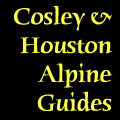

 |
 |
Aconcagua Expedition • December 31 - January 19, 2012
We have not been back to Aconcagua for nearly a decade. So when our Belgian friends Ive and Raf asked us about the possibility of organizing a trip there, we jumped at the chance. Aconcagua is primarily a fitness / acclimatization / weather challenge, and after years of soft living in the Alps (read catered huts and light packs) we wondered if we still had the guns for the type of work Aconcagua requires. Our plan was to approach the peak from the Vacas side, climb up to High Camp at almost 6000 meters, summit and then descend the normal route to Plaza de Mulas, finishing with a hike out the Horcones Valley. |

Stopping in Uspallata for lunch. Someone ordered the (scary!) trout. |

Near the start of the trek into the Plaza Argentina Base Camp. The hike into base takes 3 days. Mules carry our bags and we only need to have the essentials for the day in our light packs. |

Mules awaiting their loads at the first night's camp, Pampa Leñas. |

Just before arriving at our second camp on the trek, Casa de Piedra, David and Kathy take in our first view of Aconcagua, partly hiding in the cloud on the left in the background. |

Our second trekking camp at Casa de Piedra. |

The small "casa" after which the camp is named. |

Our last day of hiking to Base Camp, takes us up the Relinchos Valley. Aconcagua grows larger and larger as we near. Conditions look excellent with enough snow, but not too much. |

A last little valley before we arrive in the Plaza Argentina Base Camp, only some five minutes further. |

This camp was much larger than our memories of previous years. Time marches on. We found several pleasant and empty sites at the upper end of the "village". |

One evening was so snowy we rented a cooking and dining tent from our mule outfitter Fernando Grajales, for a more comfortable dinner experience. |

Ive and Raf enjoy a bit of wine. |

Getting the morning brew on. |

After a rest day in Base Camp, we made a carry up to Camp one, returning to Base for the night. |

Due to a bit of illness in the group, we decided to add one more day of rest for some of us, with the healthier folks making a second carry up to Camp One. |

Camp one, at about 4950 meters above sea level. This can be a windy spot with gusts blowing down the valley from above. |

On the carry to Camp One. |

Looking back down at Base Camp from about 4700 meters. |

We established and occupied Camp One, finding three secure rock-walled sites for our tents. |

We decided to take another day of rest at Camp One while the wind whipped up the new snow above. |

The following day was lovely, however, and we made a carry up to Camp Two at about 4750 meters. |

The following day, we moved up to Camp Two. As was all too common on this trip, we had a heavy afternoon snow shower. |

The sky cleared briefly just before sunset, offering a lovely view. |

The next morning we carry up to Camp Three, also known as Cólera Camp. The mountain above looks more suitable to skiing than climbing. |

The team on our carry day to Cólera Camp. Almost there. |

Camp at 5980 meters, Cólera Camp. |

The following day we moved up to Cólera Camp, and sure enough, that evening more snow, and lots of it. |

Looking east at sunrise. |

We arrive at the Independencia hut, about 6400 meters, just after sunrise. |

All climbers retreating. |

Looking down from the traverse. |

The macrame of trails leading up the the Nido des Condores. |

Arriving in the big city of Plaza de Mulas. |

Raf prepares to attack his first cheese burger in more than a month. |

We enjoyed a pizza dinner in Plaza de Mulas, along with the obligatory beer. |

The following day we hiked out to the road at Horcones. The winds still rage, high on the peak. |

On the hike out the Horcones Valley. |

It is a long day's walk down the Horcones, but the pleasures of motorized transport are calling us. |

Our baggage passes us. |

Looking back back up at the South Face of Aconcagua, as we near the trailhead. |

We arranged a very fine lunch at the Belasco de Baquedano winery, complete with some five courses, each paired with a selected wine. |

After the first pairing. The view from the dining room looked out over the fine vineyards. |

Matt gets lost in the Torrontés, a lovely dry white. |

And, after a fine afternoon, back to our hotel for an oxygen enriched sleep. We'll leave with a photo of the Plaza de Chile, just out the front door of our hotel. |
All images, layout and text ©2012 Cosley & Houston Alpine Guides, All Rights Reserved